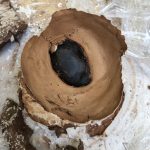Th glass casting workshop looked at the lost wax glass casting technique, using the kiln to melt the glass in a pre-formed mould. We started with moulding wax, shaping it into our desired final object. I had inspiration from bath toys, creating a platypus in a kayak. The shape we made is a positive mould, meaning the glass will be in the same shape as the wax. The displacement of the water in the jug shows how much glass we will need in a later step.
The wax then sits on top of a cone of clay, building a wall around it to hold the plaster and flint mix. The cone is used as a pouring vessel for the glass, with the sticks allowing the glass to really get into the smaller areas.
A mix of water:plaster:flint 1:1:1 was used. My walls were not strong enough and split, pouring around half of my plaster mix onto the board. I wrapped the mould in cling film, ensuring that the wall was together, and put clay at the bottom to prevent more coming out. More plaster was then poured in to complete the mould.
The clay dried quickly and I was able to take off the clay walls, and the clay cone came out smoothly, giving a nice big area for extra glass to sit in.
We used steamers to try and get the wax from inside of the moulds, however we were trying to do three at a time which was unsuccessful. Getting the wax out with the steamer one mould at a time was more successful, and was clear once washed out with hot water a couple of times. Once the wax was gone, we measured out the glass using the same water displacement system as measuring the volume of the wax. I ended up with too much glass, but tried to pour in as much smashed glass as I could as I did not mind a base to my piece. These are waiting to be sent of to the kiln, where the glass will melt and get into the details of the mould. We will get these back in a couple of weeks once they are out of the kiln and cooled.



























Leave a Reply